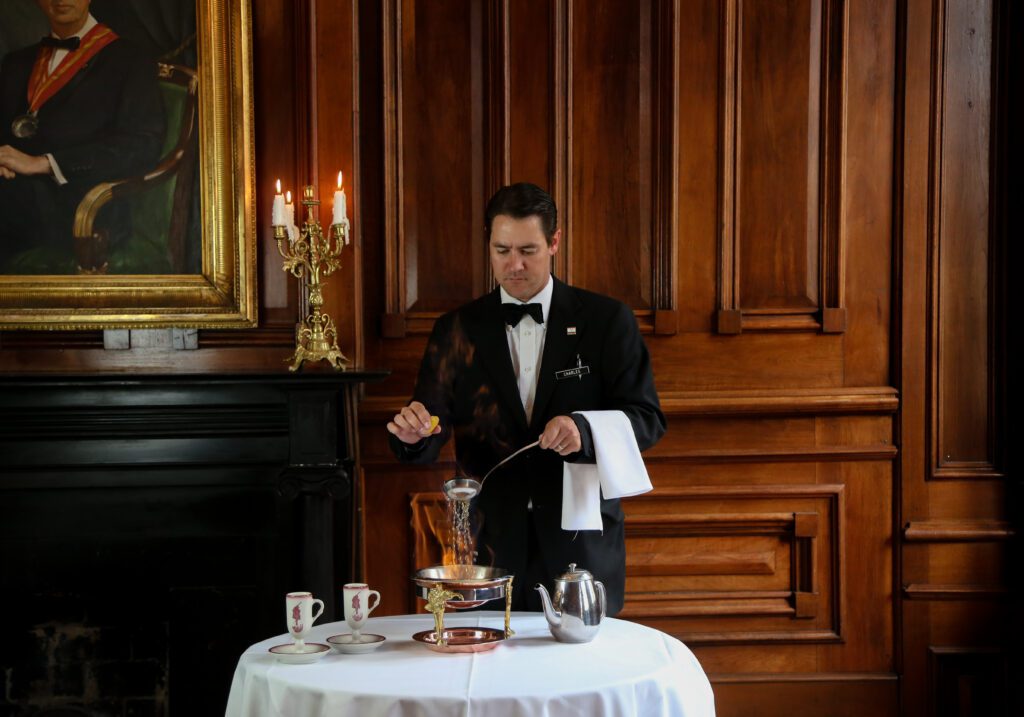Cocktail of the Month: Café Brûlot
By • March 13, 2024 0 2322

Dinner theater is a popular form of entertainment in the States, but in New Orleans sometimes the theater is part of the dinner … or at least the drinks.
Café Brûlot is one of several signature cocktails of the Big Easy. Unlike some other drinks, such as the Sazerac or the Vieux Carré, this one isn’t shaken up by a mixologist behind a bar.
The flaming coffee cocktail is prepared at a small number of select restaurants in an elaborate tableside ritual. The lavish routine involves a bit of pyrotechnics, a silver-lined punch bowl and spirals of clove-studded orange peels. The climax involves repeatedly pouring flaming brandy over curly strips of citrus, creating a dancing blaze. All this is done in dramatic fashion, with the lights dimmed in order to captivate the roomful of diners.
The name Café Brûlot literally means “incendiary coffee.” It can be found at a few of the Crescent City’s finest dining establishments. Some say its origins can be traced back to the 18th century in southern France, where Armagnac brandy is made. The region became known for a flaming Armagnac drink, infused with fruit and spices, served during celebrations after coffee.
Antoine’s, the oldest restaurant in New Orleans, claims to have invented Café Brûlot, there called Cafe Brûlot Diabolique. Jules Alciatore, son of founder and namesake Antoine Alciatore, is believed to have introduced it in the 1890s. The elder Alciatore grew up in Marseille and the younger studied there, so they would have both been familiar with France’s fiery Armagnac drink. Diabolique means “diabolic” or “devilish,” and the drink is still served today in a cup with a little devil on it.
Coincidentally, Jules Alciatore has another, more famous culinary invention on his resume, Oysters Rockefeller, named for the richness of the sauce.
Jules’s son, Roy, later took over running the restaurant and saw it through one of the most challenging times in its history: Prohibition. Café Brûlot enjoyed special popularity during this period, when coffee became a clever way to disguise the then-illegal alcohol.
This legendary libation is still served at Antoine’s, along with a handful of other esteemed eateries such as Arnaud’s and Galatoire’s. Since it’s made in large batches, it’s generally ordered for the table, not for individuals, which may be one reason it’s not found in many of NoLa’s famous bars. Antoine’s calls for a two-guest minimum per order.
Café Brûlot can be made at home, but requires specialized equipment, including a long-handled ladle and a “Brûlot bowl.” You could also use a chafing dish or a saucepan on the stove. First, pour a mixture of brandy into the bowl with cloves, cinnamon, orange and lemon peels and sugar. Next, scoop some of the brandy with the ladle and light it on fire.
Pour the brandy slowly over the citrus peels, letting it flame on the fruit, then over the other ingredients until the sugar is dissolved. Gradually add a pot of hot coffee until the flames dwindle. As the fire heats the liquid, it releases aromatics of the coffee, brandy and spices, filling the room with a bold yet comforting fragrance.
Charles Carter has been serving Café Brûlot in the Capitol Room at Antoine’s for years. He is a third-generation waiter. Both his father and his great-uncle were waiters at Antoine’s. “Café Brûlot is a unique blend of spirits, spices and New Orleans coffee,” he says. “Customers thoroughly enjoy the dramatic presentation. It is especially fun when we turn off the lights and you can watch the sparks fly. It is a great way to end an Antoine’s dining experience!”
While the exact recipe is a closely guarded secret, here is an ingredients guide to make your own version at home.
Recipe:
Peel of 1 orange, cut into 1-inch x 1/8-inch strips
Peel of 1 lemon, cut into 1-inch x 1/8-inch strips
3 sugar cubes
6 whole cloves
Cinnamon stick (2 inches)
1 cup cognac
1/2 cup Grand Marnier or other orange liqueur
2 cups fresh strong black coffee

